1. Feature Overview
Gupshup’s WhatsApp self-serve solutions help you engage your customers in a simple, secure, and reliable way. Gupshup facilitates customer support and other marketing efforts through WhatsApp. To know more, visit Gupshup.
LeadSquared offers WhatsApp integration to help users communicate with their leads. Our WhatsApp functionality supports integrations through different solution providers like Infobip, Kaleyra, WATI, Zoko and Gupshup. This article helps you set up WhatsApp messaging through your LeadSquared account using Gupshup as your service provider.
2. Prerequisites
If you’re not familiar with LeadSquared’s WhatsApp integration, see WhatsApp Business Messaging Connector. For frequently asked questions, see WhatsApp Business FAQs.
- Reach out to us at support@leadsquared.com regarding Gupshup WhatsApp integration.
- Get an Approved WhatsApp Business Number and Account.
- Submit Message Templates for Approval.
3. Installation
To know how to install the WhatsApp Business connector, refer to WhatsApp Business Messaging Connector.
4. Configuration
Once the connector is installed, add and configure your WhatsApp phone numbers to the connector. To do this, enter –
4.1 Basic Details
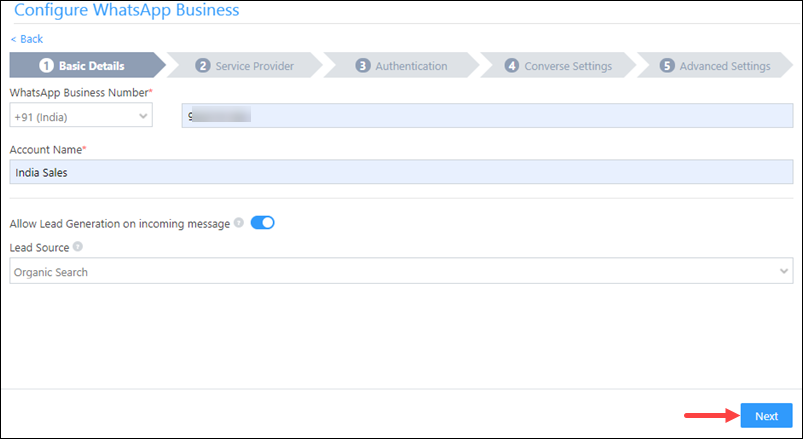
| Field | Description |
| WhatsApp Business Number | Select the country code, and provide your WhatsApp business number. This field is mandatory. |
| Account Name | Provide a relevant name for your connector. This field is mandatory. |
| Allow Lead Generation on incoming message | Click |
| Lead Source | From the dropdown, select a lead source for your leads. |
Once you’re done, click Next.
4.2 Service Provider
Then, from the available options, select Gupshup, and click Next.
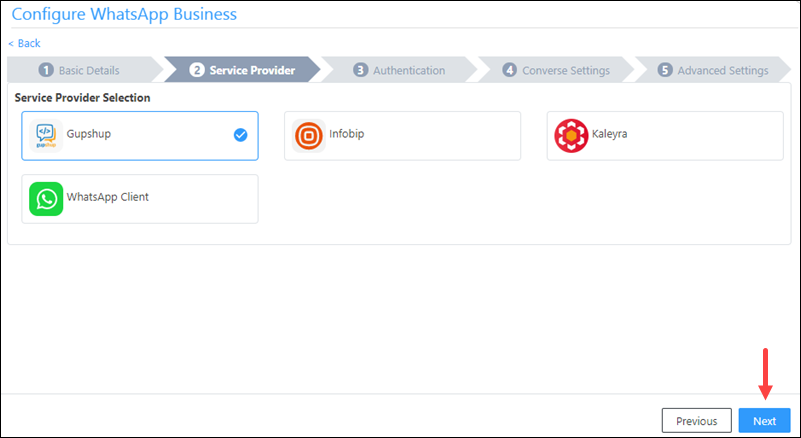
4.3 Authentication Set-up
On this screen, enter the following details –
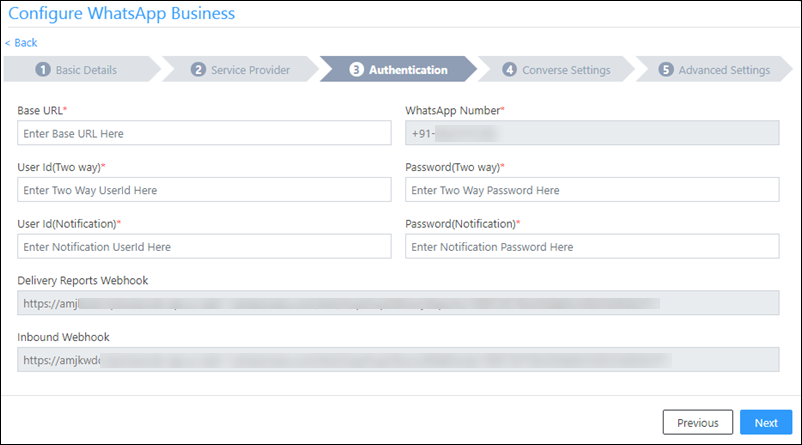
| Field | Description |
| Base URL | Paste the base URL in this field. Use the following – https://media.smsgupshup.com/GatewayAPI/rest |
| WhatsApp Number | Paste your WhatsApp business number in this field, without including any special characters such as ‘+’, etc. You will have to include the country code of the number though. An example of a number would be “9199010XXXXX”, where 91 is the country code. Contact your Account Manager from Gupshup to get your WhatsApp business number. |
| User Id(Two way) | Paste your Gupshup user Id which was generated for two-way communication. Through two-way communication, you’ll be able to send customized messages to your customers. Contact your Account Manager from Gupshup to get your two-way user Id. |
| Password(Two way) | Paste your Gupshup password to facilitate two-way communication. Contact your Account Manager from Gupshup to get your two-way password. |
| User Id(Notification) | Paste your Gupshup user Id which was generated for one-way communication. Through one-way communication, you’ll be able to send templatized messages to your customers. Contact your Account Manager from Gupshup to get your user Id. |
| Password(Notification) | Paste your Gupshup password to facilitate one-way communication. Contact your Account Manager from Gupshup to get your password. |
| Delivery Reports Webhook | The delivery reports webhook needs to be configured for the integration to be successful. To paste your LeadSquared delivery reports webhook on Gupshup, you’ll have to mail the URL to your Account Manager from Gupshup, and they’ll do the needful. Note: The webhook accepts only POST method. |
| Inbound Webhook | The inbound webhook needs to be configured for the integration to be successful. To paste your LeadSquared inbound webhook on Gupshup, you’ll have to mail the URL to your Account Manager from Gupshup, and they’ll do the needful. Notes:
|
Once you’re done entering all the details, click Next.
4.4 Converse Settings
LeadSquared Converse is an instant messaging feature that allows you to have real-time conversations with your leads via WhatsApp.
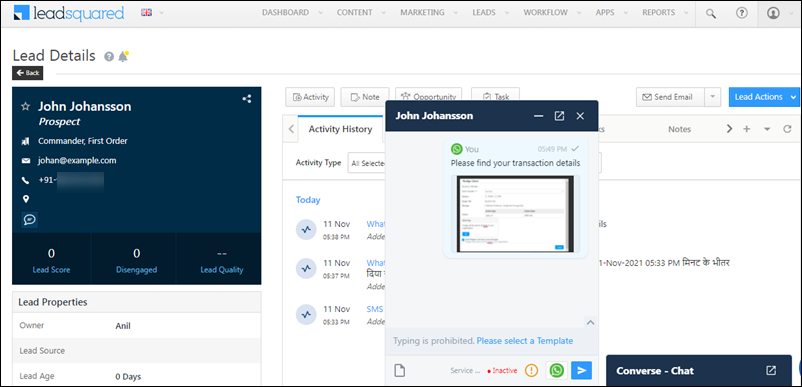
To integrate LeadSquared Converse with WhatsApp, complete the following steps –
- On the Converse Settings tab, toggle the Enable Converse
 slider.
slider. - Under User Access, grant permissions to users who can communicate with leads through the LeadSquared Converse.
- Based on Role – From the Search and Select Users dropdown, select the LeadSquared user roles that can send messages through LeadSquared Converse.
- Advanced (User Level) – Based on the value present in the selected user boolean field (e.g., For user Sam, the “Is Employee” field contains “Yes”), the user will be able to send messages through LeadSquared Converse. From the Select User Field dropdown, select a relevant boolean field.
- Functionality – The following additional settings must be configured –
- Approved Templates – Enable this functionality to allow your users to send approved WhatsApp templates to your leads.
- Unapproved Templates – Enable this functionality to allow your users to send unapproved WhatsApp templates to your leads. These can only be sent if the 24-hours service window is active.
- Notify Lead Owner* – When enabled, only lead owners will get notifications of the WhatsApp messages a lead sends. When disabled, all logged-in users will receive notifications of these WhatsApp messages.
- Sending Rich Media – Enable this functionality to allow your users to send media files in the WhatsApp messages.
Note:
- *Message notifications are only sent to one user, i.e., either the Lead Owner or to the user (other than the Lead Owner) that sent the WhatsApp message to the lead. When the Notify Lead Owner setting is enabled, only the Lead Owner will get notified, while the user who sent the message will not get a notification.
- If you enable the Send Rich Media option, you must also enable the Approved Templates option. This ensures that you can add your media files to a template when messaging your leads.
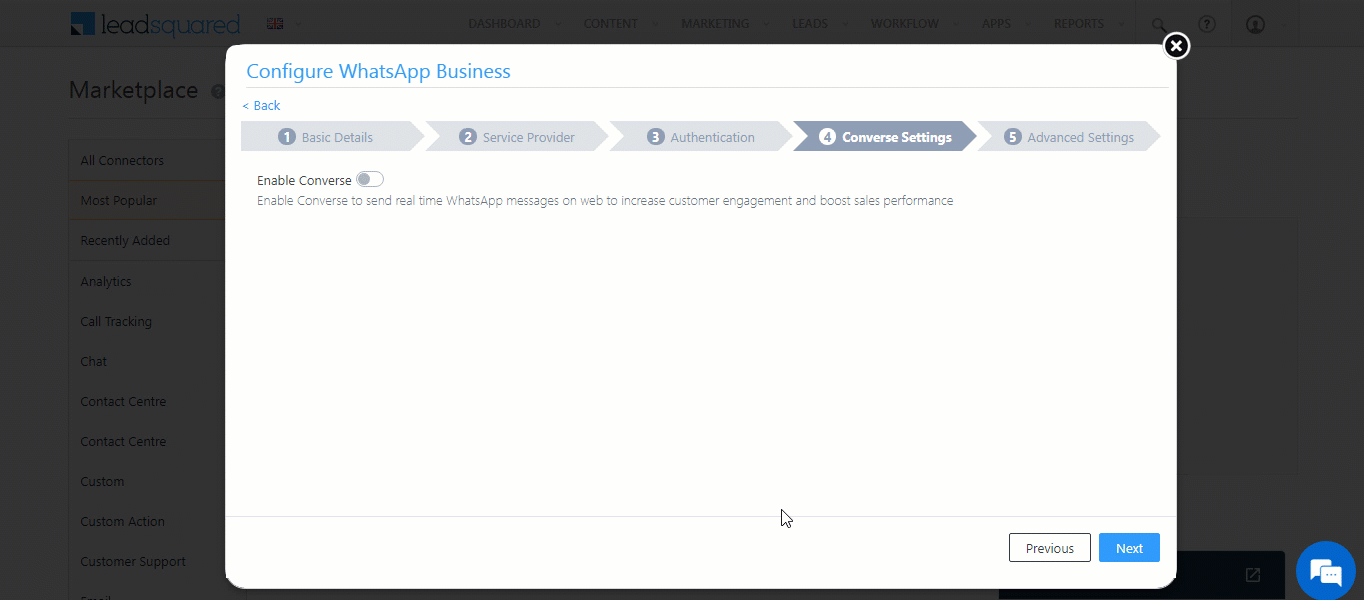
4.5 Advanced Settings
In this screen, you must map –
- Activity Mapping – A LeadSquared activity field to your WhatsApp messages. This is the activity that will be posted every time a WhatsApp message is sent or received.
- WhatsApp Opt-Out – A LeadSquared lead field to the WhatsApp opt-out functionality. Your leads can opt-in or out of receiving WhatsApp messages on the basis of this field.
- Default WhatsApp Number Fields – The number you set as the default phone number will be automatically selected when you’re sending a WhatsApp message to a lead. You can also select other numbers that are available from the Add Another Number dropdown.
- Default Country Code – The default country code will be used to send messages to a phone number that’s stored in a custom field, if no country code is listed.
- Enable Rich Media Template Support – If you want to include media files in your WhatsApp message, you must enable the
 slider.
slider. - Compliance Type – Here, you can select the compliance type for the WhatsApp template, by choosing either WhatsApp Opt-out or Opt-in.
- WhatsApp Opt-out – From the dropdown, select a lead field for the WhatsApp opt-in/opt-out functionality. Your leads can opt-in or out of receiving WhatsApp messages on the basis of this field.
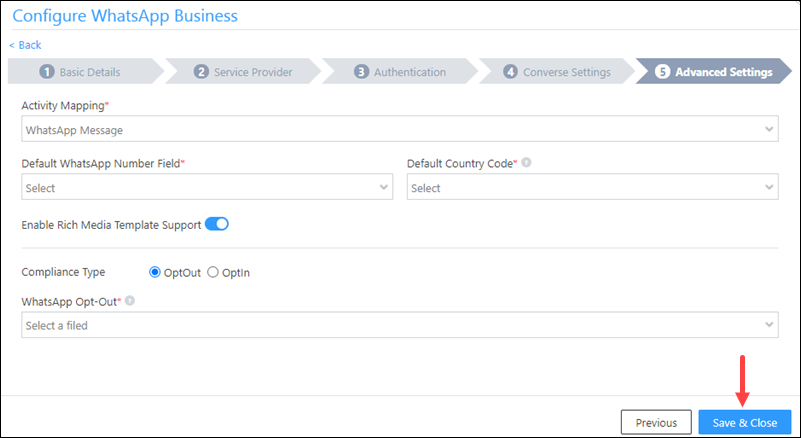
Click Save & Close when you’re done.
- If your credentials are correct, you’ll see the success message highlighted below.
- If they were incorrect, the integration will fail.
4. Conversing with Leads via WhatsApp
Integrating Converse with LeadSquared’s WhatsApp connector will enable your users to have real-time conversations with your leads through WhatsApp. Using templatised messages, you’ll be able to attach and send media files (such as images, documents, etc.) in your conversations. To know more, refer to LeadSquared Converse.

5. Next Steps
Once the connector is successfully installed, you can proceed to add WhatsApp templates and finally message your leads. For details, see Adding WhatsApp Templates to LeadSquared.
Any Questions?
Did you find this article helpful? Please let us know any feedback you may have in the comments section below. We’d love to hear from you and help you out!







I am unable to toggle the ‘Enable Converse’ button. What is the reason?
Hi Ashish, have you purchased LeadSquared Converse? If yes, please get in touch with your account manager to verify the activation status of Converse on your account. Thanks.
How to activate service window
Hi Akshay, everytime the lead responds to your message on WhatsApp, the service window automatically activates for 24 hours. To know more, refer to the Customer Service Windows section in the Conversation-Based Pricing article.